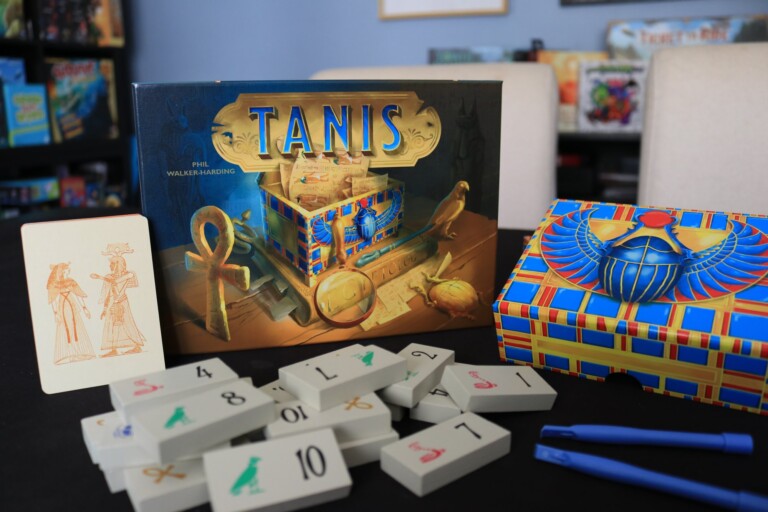As the leaves fall, the forest floor comes alive. Leaf is a beautiful tile placement and set collection game from Tim Eisner and Weird City Games. With fall in full swing and winter coming, players gain actions based on the placement of leaves in the center of the table. Using these actions, there are loads of options for players as they prepare for the cold.
The Forest Floor
Players are given three leaf cards and a player board to start the game. On your turn, you’ll play a card from your hand, pulling that leaf shape from the display. Each of these 6 leaf shapes are helpful in their own right. You’ll place this new leaf onto the forest floor, trying to connect as many glowing tips as possible to the other leaves in the center of the table.

The glowing tips of the leaves are connection points that give you actions during your turn. Each leaf color is connected to a different action. For each connection you make, you get to take that action.
- Green rewards the player with a new leaf card
- Red allows the player to grow a mushroom of their color
- Yellow gives players sun tokens that are used to advance the game toward winter
- Orange lets players choose an animal card from the display
- Brown moves the players squirrel token up the tree, earning bonus actions or points

In Leaf, every game will play out differently as the forest floor takes shape and expands. As more leaves are added by each player, the number of connection points and variety can grow. At times, you may not have the access to the colored leaves you want. It’s also possible that you only earn 2 or 3 actions on a turn due to how the edges of the forest floor look on your turn.
Gaming with a Fungi
Leaf has an aspect of area control in the form of growing player mushrooms on the forest floor. Players can grow their mushrooms using the red connection actions or by playing two identical leaf cards. During end game scoring, players are awarded victory points based on how many large mushrooms are in each group on the forest floor. It’s important to separate these into distinct groups so that you get the most victory points possible.

Connecting to the orange leaves allow players to collect animals as the game advances toward winter. There are 3 “frost” triggers in the game, one of them being at the very end of the game. Collected animals are added above the players board. Each time a frost is triggered, players can choose one animal type to place into hibernation below their board.
Animals that are in hibernation at the end of the game score victory points based on the size of the animal set. Any animals still above ground after the final frost don’t earn points for the player.

Ready for Winter
Leaf is primarily a tile placement game with gorgeous and complex tiles. We’re so used to tile placement games having square or polyomino tiles, that Leaf creates a unique puzzle with the way that action points are earned with each connecting leaf tip.
Whether playing with 2, 3, or 4 players, no two games are the same. The forest floor is unique with every play. This leads to every player staying engaged while they look for the connections that earn the actions that they need.

Leaf offers players a number of avenues to gain victory points which are represented by acorns. Sun tokens can be turned in to earn victory points while also bringing the end of the game closer. Set collection of hibernating animals can earn 6 or more points per set. Mushrooms that are strategically grouped can earn big points. No matter where you look, points are available.
During our play, there is one thing we noticed that is worth mentioning. Since the leaf tiles are all reliant on the tips of the leaves touching, playing on a slick surface or a table without texture can be a little frustrating. If a player isn’t paying attention, it’s pretty easy to knock the forest floor display out of alignment. My brain is a little more finicky when stuff like this happens. Our best experiences where when playing on a gaming mat or textured table where the cardboard leaves don’t slide around.

Falling for Leaf
Leaf is a pretty chill game. Players are in competition but also have to share the central space where leaf tiles are placed. My first experience with the game was with my wife Erin over a cup of coffee. This feels like the right fit for this game.
It’s beautiful Autumn color palette from artist Angela Rizza, along with easy to navigate gameplay, is just right for a casual game night or a relaxing evening, although there are definitely moments where players can press the buttons of their opponents. Moving the sun tracker into a Frost phase before other players are ready for hibernation is a great way to keep players from optimizing their points. Blocking access to specific colors of leaves are another way to keep actions away from the competition.

Not only is Leaf beautiful, but it’s also built with sustainability in mind. You’ll notice once you open the box that there’s not a single piece of plastic in the game. Wooden tokens, recycled cardboard pieces, and tuck boxes hold everything you need in the game. Weird City Games did a fantastic job considering the environment when producing this game.
Leaf is a game that is so different than any of our other nature themed games. The action point system Tim Eisner created here feels unique and very accessible for new players. Fall is coming and Leaf might be a great addition to your game library this season.
You can purchase Leaf at your local game store this October or online through the Weird City Games webstore.
This game was provided to us by the publisher for review. Read more about our review policies at One Board Family.
Highs
- Unique action point mechanic using leaf tiles
- Forest floor display is unique every single game
- Lots of opportunities to gain points
Lows
- Leaf display can slide and misalign on a slick play surface
Complexity

Time Commitment

Replayability






